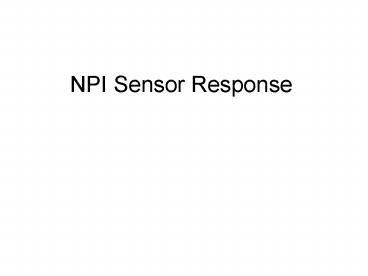NPI Sensor Response
Title:
NPI Sensor Response
Description:
NPI Sensor Response –
Number of Views:40
Avg rating:3.0/5.0
Title: NPI Sensor Response
1
NPI Sensor Response
2
Neutral Particle Imager
3
NPI Sector Orientation
31
0
24
7
23
8
16
15
4
NPI Data Available
- Cruise Phase data (10 sessions)
- Orbits 44, 47 and 49 (nadir pointing)
- Orbits 97, 100 and 103 (nadir pointing, Sun in
-Z)
5
Cruise data
45
42
July 9
6
July 9 1830
5.543e5
7
UV-Calibration of VEX NPIat University of
Arizona with Charles Curtis and Bill Sandel
- Hydrogen Lyman a (?121.6 nm)
- During measurements 7 106 s-1 into NPI
aperture (gross estimation)
8
Wavelength nm
- (VEX) NPI has a UV rejection factor of 10-5.
- (MEX) NPI sees 310-5 counts from Sun.
9
Simulations
Dusk
SZA
Dawn
SZA 120
- NPI simulation at Mars (based on hybrid model.
Kallio et al., Geophysical Research, 2001). - Determine/approximate extent of Sun
contamination.
10
Best Case
11
Worst Case
12
NPI Mars Orbit Data
Particle FOV 3
Draw Mars 20
NPI
Draw the Sun 30
S/C
Particle FOV 3
Draw Mars 20/-5
Draw the Sun 30/-5
13
Orbit 44
14
Orbit 47
15
Orbit 49
16
Orbit 97
17
Orbit 100
18
Orbit 103
19
Orbit 103 With Simulation Contour
20
Summary
- NPI is sensitive to Sun (UV rejection 10-5).
- Ghost reflections appear 180 from primary at
high count rates. - We only see half of Mars (is the MOCAD for
sectors 24-31 misbehaving?). - Simulated ENAs in the Sun-direction for orbit 103
consistent with data (backscattered ENA from Mars
not included in model).
21
A QUICK LOOK AT NPI
22
WHAT IS FALSE?
SHARP CUT-OFF HERE
15-19 AND 0-3 FOLLOW EACHOTHER NICELY!
SECTORS 24-31 TOO LOW!?
NO SHARP CUT-OFF HERE
?
23
WHAT IS FALSE?
Autocorrelation over sectors as a function of
time. Y-axis does NOT show actual sector number,
but separation (lag) between sectors for which
the correlation is calculated. NOTE how the
autocorrelation drops significantly below 1 at
1712. This about the time for ecliptic
crossing,and when the sun goes from the
instrumental hemisphere containing the negative
S/C y-axis, to the positive side.
24
Orbit 44
GHOST REFLECTIONS
DIRECT SUN
25
Orbit 103
ALBEDO (ENA SUN?)
SHARP BOUNDARY
GHOST REFLECTION OF 0-3?
26
0
31
15
16
to here
SUN moves from here.
Sun at 1712 UT
Strong emissions in sectors 11-19 (see previous
slide) goes away abruptly as soon as the Sun
switches sides and is blocked by the S/C. This is
an indication that these sectors see photons
before 1712 UT. One could argue that these
affect sectors 0-3 as well (ghost reflections?).
27
WHAT IS REAL?
Ghost reflections
GROUP 2
GROUP 1
ENA albedo (50 of incoming ENA flux) Sun albedo
(30 of sunlight)?
GROUP 1
GROUP 2
Solar wind ENAs and/or sunlight
- Klas and Herbert is comparing to simulations.
Pontus is just handwaving at this point. - GROUP 1 Weaker emissions appears to come
closer to the limb after 1702 UT. This is
consistent with emissions close to the limb when
the spacecraft distance is increasing. - GROUP 2 Sun should be within FOV at 1712 UT,
but NO sun pulse!? Theres a tiny streak of weak
emissions running through the sectors. Sunpulse
or solar wind ENAs?
28
SUMMARY
- Sectors 0-8 and 16-23 are susceptive to ghost
reflections. - Sectors 24-31 are too low.
- This explains sharp sector boundary 19-20.
- Use cruise data to correct for ghost reflections?
- Other curious sector behaviors exist.
- HOW ARE PRE-AMPS AND SECTORS RELATED?
29
SKYMAP DISPLAY
- When NPI scans, it paints the sky just like
being inside a sphere. - The scan axis (S/C z-axis) is the north pole of
this sphere. - The latitudes of the sphere are the sectors of
NPI. - The longitude is the scan angle.
- Close to what a human eye would see.
- NPI is not yet scanning. Only a slit is shown
(its enlarged to 15 deg. Should only be 5 deg.) - SPF x,y,z axes are drawn, with annotation on the
positive end. - Equatorial rings of planetary radii 2,4,6 are
drawn.
30
(No Transcript)































